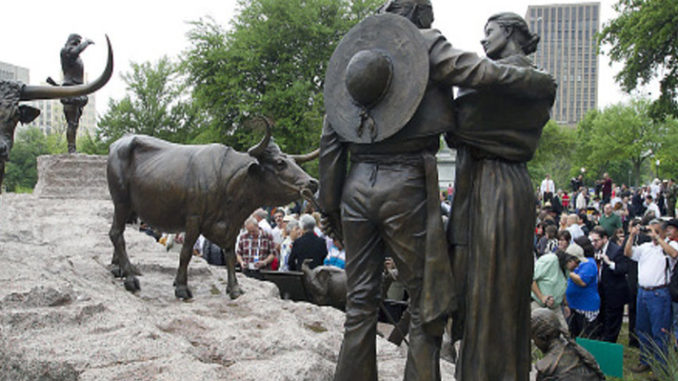
by José Antonio López
For most of the past three years, immigration has taken the lion’s share of the news. There’s one primary reason: Anti-immigration border wall coverage on TV is constant.
Certain politicians and news personalities even used it as their tool of choice during the 2018 midterm elections. By maintaining the assault, they stoke a volatile firestorm of fearmongering they created precisely for political purposes.
 As lateral targets, U.S. citizens of Mexican-descent suffer, as well. They are increasingly objects of bigotry just because they exercise their First Amendment right to speak Spanish — as two vacationing women experienced in Montana last year when their conversation in a convenience store a led to their detention by a Customs and Border Protection agent.
As lateral targets, U.S. citizens of Mexican-descent suffer, as well. They are increasingly objects of bigotry just because they exercise their First Amendment right to speak Spanish — as two vacationing women experienced in Montana last year when their conversation in a convenience store a led to their detention by a Customs and Border Protection agent.
Not surprisingly, mainstream society is just as misinformed about immigration as they are about early (pre-1836) Texas history. The two issues are related.
Maintaining a rigid intolerant stance, self-described white nativists are quick to employ two primary themes in condemning today’s immigrants: “Respect U.S. national borders,” and “U.S. sovereignty is sacred.”
The truth is that violating borders and disrespecting the sovereignty of other countries are main features of our national makeup. The U.S. violated those two noble principles by seizing more than half of Mexican-sovereign territory.
By invading Mexico, the U.S. placed the present U.S.-Mexico border in the middle of Old Mexico, single-handedly producing the current dilemma on our southern border.
The U.S. looks as it does today because of President James K. Polk’s ploy, the U.S.-Mexico war of 1846-48. Extracting harsh terms for ending the war, the U.S. unilaterally moved Texas’ southern border from the Nueces River to the Rio Grande, separating Texas and South Texas — then the northern part of the state of Tamaulipas — from Mexico, but also subsuming present-day New Mexico, Arizona, California, Colorado, parts of Utah and Nevada, and the surrounding region all the way to the Canadian border.
Fifty years later, in 1898, the U.S. again violated another country’s sovereignty by invading the Hawaiian Islands. Unfairly consuming the islands and adding them to its empire, the U.S. deposed Queen Lili’uokalani, the sovereign head of Hawaii.
To this day, her descendants and Native Hawaiians oppose the U.S. occupation of their land.
As for the current debate over our border with Mexico, consider the following situation: Imagine you live in a home you built on a large tract of land that’s been in your family for many years. For some time now, you’ve noticed your next-door neighbor disregarding the fence boundary. You watch as he and his family and friends make themselves at home in your backyard.
You wait, hoping your neighbors come to their senses and realize they’re trespassing. Instead, you are surprised when your neighbor knocks on your door and demands that you move your back fence closer to your house.
Of course, you protest and are compelled to fight back. Sadly, the neighbor is better armed, and you lose the fight. Worse, under duress you are forced to give the invader more than half your land.
In “The Mexican-American War of 1846-1848 (A Deceitful Smoke Screen),” author Humberto Garza presents a well-researched account of the deliberate steps that Polk took to fulfill his expansionist ambitions. Specifically, sending the military and armed agents to bully Mexico into a shooting war.
So, what does mainstream U.S. history say about this violent encounter? Well, first it insists that it was all Mexico’s fault. That may be why mainstream historians sometimes refer to the U.S.-Mexico War as the “Mexican War,” thereby disowning any U.S. responsibility.
Second, in winning the war, the U.S. version of history has an Anglo Saxon narrative. That’s because conventional U.S. historians have traditionally hidden the heavyhandedness of the “Colossus of the North” in its adverse acquisition of Mexico’s sovereign land.
According to Polk, the U.S. was defending itself because Mexican soldiers killed U.S. soldiers on U.S. soil (in Texas). That refers to an incident in which a U.S. military unit crossed the Nueces River into the state of Tamaulipas. Warned to leave Mexico, the Anglo trespassers refused. They were then defeated in battle.
Polk planned this event, was waiting for it and used it to his advantage. Using the ruse to agitate his pro-war supporters, Congress expansionists quickly approved funds to conduct Polk’s war of aggression.
Sadly, although Mexican troops honorably and heroically defended their sovereign soil, they were overwhelmed by the U.S. invaders.
In reconsidering the events, not only is the starting point for the war flawed, but the entire foundation was built within a fog of lies. For one thing, Polk’s staged clash was geographically untrue. The incident took place in northern Tamaulipas, not Texas.
Not all national leaders supported Polk’s land grab. Speaking for integrity, Congressman Abraham Lincoln helped write an amendment to a House resolution declaring that the war with Mexico was “a war unnecessarily and unconstitutionally begun by the President of the United States.”
Lincoln also challenged Polk to provide not only convincing proof of the serious charges but also the exact location where the incident had taken place. Following is Lincoln’s assessment:
“But, if he (Polk) cannot or will not do this (prove the Texas claim to the Rio Grande border) — if on any pretense or no pretense he shall refuse or omit it — then I shall be fully convinced of what I more than suspect already — that he is deeply conscious of being in the wrong; that he feels the blood of this war, like the blood of Abel, is crying to heaven against him.”
Despite Lincoln’s astute appeal, the president refused to budge. That’s because Polk was obsessed with delivering his major campaign promise to his base: U.S. expansion to the Pacific Ocean at the expense of the sovereign Republic of Mexico.
Polk had long planned to provoke Mexico by admitting Texas into the union as a slave state; taking advantage of Mexico’s chaotic political instability; supporting a small group of Anglo immigrants’ revolt in California; and plotting with other expansionists to coerce Mexico into selling New Mexico to the U.S.
History records that his devious plan worked.
Knowledge feeds understanding; intolerance breeds ignorance. My sincere expectation is that this article serves to counteract today’s narrow-minded argument regarding U.S. borders and sovereignty.
In that regard, it is fitting to end with the words of Gen. Ulysses S. Grant, the 18th president of the United States. He wrote these words to explain his regret for being involved in the war and to expose U.S. contempt for Mexico’s borders and sovereignty:
“For myself, I was bitterly opposed to the measure, and to this day, regard the war with Mexico, which resulted, as one of the most unjust ever waged by a stronger against a weaker nation. It was an instance of a republic following the bad example of European monarchies, in not considering justice in their desire to acquire additional territory.”
José “Joe” Antonio López was born and raised in Laredo and is an Air Force veteran. He lives in Universal City. His latest book is “Preserving Early Texas History (Essays of an Eighth-Generation South Texan), Volume 2”. Lopez is also the founder of the Tejano Learning Center and www.tejanosunidos.org, a website dedicated to Spanish-Mexican people and events in U.S. history.



